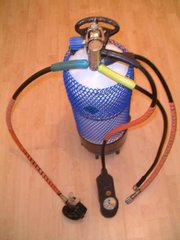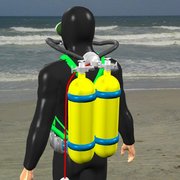Diving regulator
|
|
A diving regulator is a gas pressure regulator which supplies SCUBA divers with breathing gas at ambient pressure from a diving cylinder.
| Contents |
|
|
Types of regulator
Two stage, single hose
Most modern scuba regulators are of this type.
The first stage is a pressure reducing valve that takes gas from the diving cylinder at pressures of 200 - 300 bar (3000 - 4700 psi) and reduces its pressure down to 10 bar (140 psi) higher than ambient pressure in the hose.
The second stage valve delivers the gas from the single hose to the place it is required. It can have one of the following activation mechanisms. It could be a "demand valve" operated by the diver's inhalation from the valve. It could be manually operated valve or a solenoid-operated valve.
Demand valve second stage
The demand valve, second stage or DV is the device connected to a low pressure hose from which the diver inhales. It detects when the diver starts inhaling and supplies the diver with a breath of gas at ambient pressure. It reduces the gas pressure in the hose from 10 bar (140 psi) above ambient pressure to ambient pressure. Most modern, open circuit scuba sets use this type of second stage.
It consists of a chamber, a valve at the end of the low-pressure hose and a mouthpiece, which the diver grips between his or her teeth. A diaphragm at the front of the chamber controls the valve on the low-pressure hose. The diaphragm operates when the "purge button" on the front of the demand valve is pressed or when the diver lowers the pressure inside the chamber by trying to inhale. In either case low pressure gas is released into the chamber removing any water in there, allowing the diver to inhale and pushing the diaphragm back so that the valve closes. When the diver exhales the exhalation diaphragm flexes and allow the gas to escape to the water outside the demand valve.
Some passive semi-closed circuit rebreathers use a form of demand valve, which senses the volume of the loop and injects more gas when the volume falls below a certain level.
Manually operated second stage
This type of second stage is used in buoyancy compensator inflation valves and in rebreather loop inflation valves. A simple button allows the valve to be opened.
Solenoid operated second stage
This type of second stage is used automated fully closed-circuit rebreathers to maintain the oxygen partial pressure of the loop.
Twin-hose
This type of regulator had two wide, corrugated, breathing tubes. The first and second stages of the regulator were in a large circular valve assembly mounted on top of the cylinder pack. One-stage and three-stage regulators were known. The second, return tube was not for rebreathing but to balance the regulator's second stage diaphragm to regulate the flow of gas. Raising the mouthpiece above the regulator increased the flow of gas and lowering the mouthpiece increase breathing resistance.
The relatively large volume of the hoses forced divers to carry more weight underwater to compensate. An advantage with this type of regulator is that the bubbles leave the regulator behind the divers head increasing visibility. They have been superseded by the single hose regulator and become obsolete in the 1980s.
The twin hose mouthpiece has reappeared in modern rebreathers but as part of the breathing loop, not as part of a regulator.
Constant flow
Constant flow regulators are the earliest type of diving regulator. They are also used in active semi-closed circuit rebreathers. With a constant flow regulator the diver is provided with breathing gas at a constant rate. The only control the diver has is to open or close the valve to the cylinder. Constant flow vales consume gas less economically than demand valve regulators because gas is provided even when it is not needed.
With active semi-closed circuit rebreathers, the diver installs one of a number of different sized orifices in the valve before the dive. For safety reasons these should be chosen to provide more gas than the diver needs, to avoid hypoxia.
There were attempts at designing and using constant flow regulator before 1939, for diving and for industrial use. Examples were "Ohgushi's Peerless Respirator" where the valve was operated by the diver's teeth, and Commandant le Prieur's breathing sets (see Timeline of underwater technology).
Parts of a modern single hose regulator
Diving_regulator.JPG
Diving_regulator_contents_guage.JPG
Main components of a diving regulator, which supply the diver with breathing gas are:
- the first stage
- one or more low pressure hoses
- one or more demand valves or second stages
In order to monitor breathing gas pressure in the diving cylinder, a diving regulator is usually equipped with:
- the high pressure hose
- the contents gauge
In some cases, the diving regulator may be equipped with
- a pressure relief valve
First stage valve
The first stage has either an A clamp or a DIN fitting to connect it to the pillar valve of the diving cylinder. It has a number of "ports", which allow low and high-pressure hoses to transport gas to other components.
The mechanism inside the first stage can be of the diaphragm-type or the piston-type. Diaphragm regulators are simpler than piston regulators, but need more careful maintenance so are less suitable for diving at locations with limited services. With piston-type regulators, the piston is rigid and acts directly on the seat of the valve. On diaphragm-type regulators, the diaphragm is flexible and lifts the rod opens and closes gap at the seat. Both types can be balanced or unbalanced. The performance of unbalanced regulators decreases as the cylinder pressure falls, so they are only suitable for divers who only do shallow diving or for training.
As gas leaves the cylinder it decreases in pressure in a regulator, becoming very cold. In conditions where the water temperature is less than 5 °C any moisture inside the regulator may freeze, preventing the valve closing, causing a free-flow that can empty a full cylinder within a minute or two. The modern trend of using more plastics, instead of metals, within the regulators encourages freezing because it insulates the inside of a cold regulator from the warmer surrounding water. Environmental sealing and teflon coatings are used to reduce the risk of freezing inside the regulator.
Low pressure hose
All breathing regulators have a hose that connects the first stage to the demand valves. Some low pressure hoses are known as direct feeds. They supply gas to the diving suit and the buoyancy compensator inflation valves.
The first stage delivers gas at about 10 bar above the ambient pressure to low pressure hoses. That is a between the high pressure in the cylinder and the ambient pressure, that's why they are sometimes called medium pressure hoses.
Demand valve
Sometimes a regulator has more than one DV. If it is simply a spare DV for use by the diver's buddy it is generally called an octopus. Another possibility is: it could be a hybrid DV and buoyancy compensator inflation valve. Both types are called alternate air sources and more confusingly a DV on a regulator connected to a separate, independent diving cylinder would also be given that name.
High pressure hose
The high pressure hose takes gas, at cylinder pressure, direct from the high pressure inlet of the first stage to the contents gauge.
Contents gauge
The contents gauge is a pressure gauge measuring the gas pressure in the diving cylinder so the diver knows how much gas remains in the cylinder. It is also known as submersible pressure gauge or SPG.
There are several types of contents gauge:
- The standard type is an analogue gauge that can be held in the palm of a hand and is connected to the first stage by a high pressure hose. Sometimes they are fixed in a console, a plastic or rubber case, that holds the air pressure gauge and one or more of a depth gauge, a dive computer and a compass.
- Button gauges are coin-sized, analogue gauges that are connected directly to the first stage. They are often used on decompression cylinders. Due to their small size, it can be difficult to read the gauge to a resolution of less than 20 bar / 300 psi.
- Air integrated computers. Some dive computers are designed to measure, display and monitor pressure in the diving cylinder . Although this can be very beneficial to the diver, it does mean that if the dive computer fails, the diver can no longer monitor his or her gas reserves. The computer is either connected to the first stage by a high pressure hose or has two parts, the pressure transducer on the first stage and the display at the wrist or console, which communicate by radio link.
- In the past, some types of diving cylinder had a mechanical reserve release lever that provided a warning to the diver that the gas supply was nearly exhausted
Pressure relief valve
A pressure relief valve is a safety device that must be used if no demand valves are present on the regulator. It allows gas to escape from the first stage in the event of a malfunction, without over-pressurising any other regulator components, such as diving suit or buoyancy compensator inflation valves.
Normally, if present, a demand valve will vent off safely the excess gas from the first stage malfunction. This is called a free flow and is designed as a fail safe feature so that the diver can continue to breathe for a few seconds or minutes until all the gas is rapidly exhausted. If there is neither a demand valve nor a pressure relief valve there is a danger the excess gas will free flow to the buoyancy compensator or diving suit resulting in a rapid increase in buoyancy causing a potentially lethal rapid ascent to the surface.
Performance of regulators
ANSTI (http://www.ansti.co.uk/) has developed a testing machine that measures the inhale and exhale effort in using a regulator. Publication of results of the performance of regulators in the ANSTI test machine has resulted in big performance improvements.





